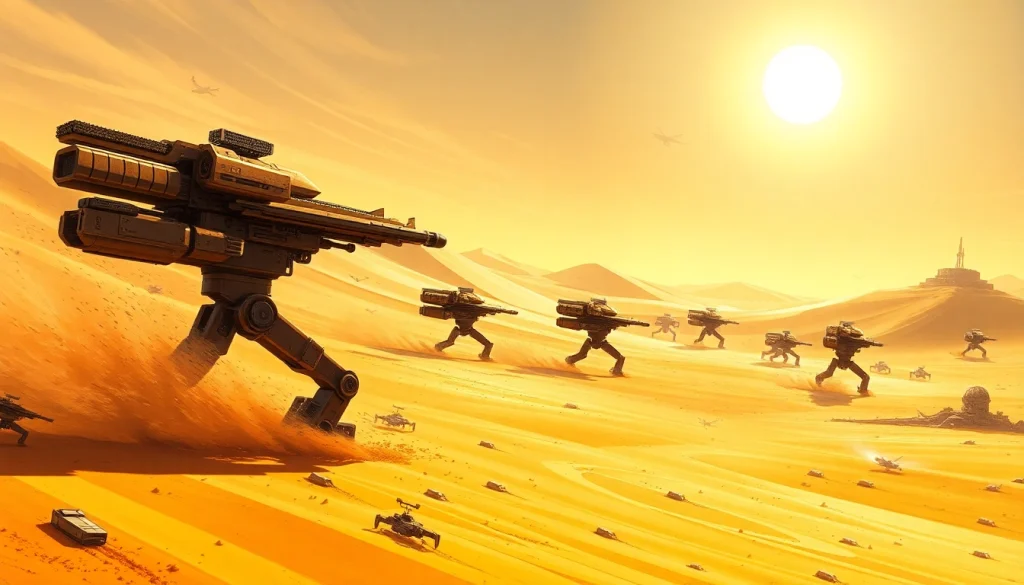Introduction to Dune 2 Game
Launched in 1992, the dune 2 game holds a significant place in the history of real-time strategy games. Developed by Westwood Studios and published by Virgin Interactive Entertainment, this remarkable game emerged as a pioneer in the genre, showcasing innovative gameplay and strategic depth that continues to resonate with players today. Its success paved the way for future franchises and redefined conventions in game design.
Background and Release
Dune II: The Building of a Dynasty is often credited as the first true real-time strategy (RTS) game. Building on the foundation established by its predecessor, Dune, the game brings players into the formidable universe envisioned by Frank Herbert. It incorporates resource management, base building, and unit command into a seamless experience, making it a standout title in the early 90s gaming landscape.
The game was originally released on multiple platforms including DOS, Amiga, and Sega Genesis and quickly captivated audiences with its rich narrative and engaging mechanics. The use of the Dune universe, with its intricate lore, gave players a unique backdrop for their battles, allowing them to command one of three factions: House Atreides, House Harkonnen, or House Ordos.
Key Features of Dune 2 Game
Among its most notable features, the dune 2 game is recognized for:
- Resource Management: Players must harvest precious spice, the game’s primary resource, to expand their base and build armies.
- Unit Variety: The game offers a multitude of units ranging from basic infantry to powerful tanks, allowing for diverse strategies.
- Base Building Mechanics: Players construct and upgrade facilities to produce units and enhance their military capabilities.
- Dynamic AI: The enemy AI adjusts its strategies based on player actions, creating a challenging and unpredictable environment.
- Cinematic Elements: The game integrates engaging cutscenes that immerse players in the unfolding narrative, enriching the overall experience.
Why Dune 2 Game Remains Popular
Despite being over three decades old, Dune II has maintained a dedicated fanbase due to factors like its accessibility and the nostalgic appeal of retro gaming. Its influence on subsequent RTS games is undeniable, as it introduced mechanics that would become hallmarks of the genre, such as fog of war and the concept of base-building in a battlefield context. Many modern strategy games continue to draw inspiration from its gameplay and design principles.
The game’s enduring popularity is bolstered by the emergence of DRM-free versions and emulators that allow a new generation of players to experience its groundbreaking mechanics. Furthermore, active online communities continue to explore and discuss strategies, perpetuating interest and excitement around the game.
Dune 2 Game Gameplay Mechanics
Basic Controls and Gameplay Flow
The controls for dune 2 game are straightforward, allowing players to navigate the game quickly. The interface provides intuitive commands for selecting units, issuing movement orders, and engaging in combat. Players can zoom in and out of the battlefield to manage units effectively or gain situational awareness during large-scale battles.
The gameplay flow consists of strategizing resource allocation for unit production while simultaneously scouting the map for enemy movements. The necessity for quick decision-making becomes apparent as players learn to adapt and evolve their strategies based on enemy tactics and the ever-changing battlefield landscape.
Understanding the Economy in Dune 2 Game
At its core, dune 2 game revolves around economic management. Spice is the lifeblood, accumulating through harvesting and determining a player’s success. Effective management of spice resources is crucial, as it influences every aspect of gameplay: from construction speeds to the creation of military units.
Players should focus on constructing refineries early to ensure a steady flow of spice and avoid resource shortages. Investing in upgrade buildings can further enhance harvesting efficiency and production capacities, directly impacting the player’s ability to maintain a robust army.
Strategic Planning and Unit Deployment
Strategic planning in the dune 2 game requires careful consideration of unit types and terrain. Players must evaluate each faction’s strengths and weaknesses while leveraging the appropriate units to secure victory. A sound strategy involves understanding when to engage in combat, when to withdraw, and how to fortify defensive positions with structures and turrets.
Utilizing terrain effectively is paramount; high ground offers strategic advantages for attack and defense, while choke points can be exploited to hinder enemy advances. Flanking maneuvers and overwhelming force can quickly turn the tide of battle, emphasizing the importance of tactical flexibility and foresight.
Units and Factions in Dune 2 Game
Overview of Different Factions
In the dune 2 game, players can choose one of three factions, each with distinct characteristics:
- House Atreides: Known for their balanced approach, they excel in mobility and unit versatility. Their ability to deploy mental units offers strategic intelligence advantages.
- House Harkonnen: A faction centered around brute force, they feature heavily armored units that can absorb damage but may lack speed. Players can overwhelm foes with sheer strength.
- House Ordos: With a focus on stealth and tactics, they incorporate unique units with special abilities, making them unpredictable enemies.
Choosing the right faction can significantly influence combat strategies and overall gameplay success, necessitating players to adapt their strategies accordingly.
Unit Types and Their Roles
The dune 2 game features a diverse array of units, each fulfilling different roles on the battlefield:
- Infantry: Basic units effective in scouting and capturing territory.
- Vehicles: Fast and heavily armed units designed for offensive maneuvers.
- Air Units: Possessing superior mobility, they are essential for reconnaissance and quick strikes.
- Defensive Structures: Turrets and walls protect bases and slow enemy advances, serving as deterrents during critical phases of gameplay.
Each unit type complements others, allowing players to construct a comprehensive tactical approach that blends offense and defense seamlessly.
Best Strategies for Each Faction
To maximize their chances of victory, players must tailor strategies to fit their chosen faction:
- For House Atreides: Emphasize mobility and scout frequently, utilizing positioning to outmaneuver enemies.
- For House Harkonnen: Focus on building an overwhelming army and using heavy units to crush opposing forces.
- For House Ordos: Employ stealth tactics to ambush and confuse enemies—strength in deception is crucial.
Adapting to the dynamics of each faction not only enriches gameplay but also cultivates a deeper understanding of the comprehensive strategical layers inherent in dune 2 game.
Advanced Strategies for Dune 2 Game
Effective Base Building Techniques
Base building is a critical component of the dune 2 game. Efficient layouts maximize space and resources while providing tactical advantages. Concentrate critical structures near spice fields to facilitate quick access to resources. Prioritize building refineries and barracks early on to strengthen your economy and military capabilities.
Integrating defensive structures into your base design can thwart enemy incursions, while placing production facilities strategically allows for rapid unit deployment in response to threats. Continual upgrades enhance defensive and offensive capabilities as the game progresses.
Battlefield Strategies Against Opponents
Understanding your opponent is paramount in dune 2 game. Observing unit composition and adapting tactics accordingly can force errors and lead to strategic advantages. Map control is critical; denying your enemy access to resources and strongholds disrupts their capabilities.
Using distraction techniques, such as decoy units or feigned withdraws, can lure opponents into traps, allowing for flanking maneuvers or coordinated attacks with your strongest units.
Utilizing Resources Wisely in Dune 2 Game
Maximizing the utilization of resources is essential for long-term success in the dune 2 game. Players should continuously scout and control spice fields, as their collection ensures sustained unit production and upgrades. Balance the allocation of resources between building defenses and offensive units, maintaining flexibility in response to evolving battlefield conditions.
Moreover, preserving resource excess through careful management can fund late-game strategies and upgrades that turn the tide decisively in your favor.
Community and Legacy of Dune 2 Game
Fan Communities and Resources
The dune 2 game has fostered a vibrant community over the decades. Forums, subreddits, and discords dedicated to the game offer rich avenues for players to share strategies, fan art, and modifications. Many enthusiasts continue to create content, including tutorials and gameplay videos that introduce the game to new players.
This community aspect not only enhances engagement but serves as a valuable resource for learning advanced tactics and discovering hidden secrets within the game.
Legacy and Impact on Real-Time Strategy Games
Dune II’s legacy transcends nostalgia; it fundamentally shaped the RTS genre. Its principles inspired countless games, establishing frameworks for unit management, resource allocation, and strategic depth still prevalent today. Innovations introduced in Dune II, such as the fog of war and unit pathfinding improvements, became exemplars that subsequent titles emulated.
The influence of Dune II showcases how a singular innovative title can ripple through the gaming industry, setting standards and paving paths for the future of game design.
Where to Play Dune 2 Game Today
Today, players can relive the classic experiences of the dune 2 game through various platforms and emulators. Many websites host versions of the game that are optimized for modern systems, allowing both long-time fans and newcomers to enjoy this legendary title easily. Community-driven projects may even offer modern remakes that enhance graphics while preserving the core gameplay that made the original compelling.
Whether through original installations or browser-based initiatives, access to Dune II remains alive, ensuring its place in gaming history is celebrated and enjoyed for years to come.


